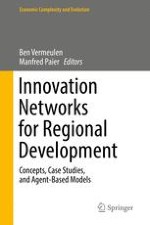2017 | OriginalPaper | Buchkapitel
Innovation Networks to Cope with the Geographical Distribution of Technological Knowledge. An Empirically Calibrated Spatial Agent-Based Model Study
verfasst von : Ben Vermeulen
Erschienen in: Innovation Networks for Regional Development
Aktivieren Sie unsere intelligente Suche, um passende Fachinhalte oder Patente zu finden.
Wählen Sie Textabschnitte aus um mit Künstlicher Intelligenz passenden Patente zu finden. powered by
Markieren Sie Textabschnitte, um KI-gestützt weitere passende Inhalte zu finden. powered by
